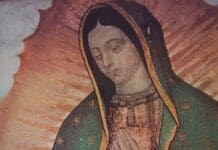For centuries, the Feast of the Assumption of the Blessed Virgin Mary on August 15 has been a cornerstone of Catholic tradition.
It marks the day Mary was believed to have been taken bodily into Heaven after her earthly demise. However, this widely accepted belief was only formally declared a dogma – an essential teaching of the Catholic Church – in 1950.
The Assumption is intertwined with the Feast of the Immaculate Conception on December 8th. Both are primary feasts dedicated to the Blessed Virgin and are Holy Days of Obligation, making them among the most significant feasts in the Catholic calendar.
While the concept of Mary’s assumption dates back to narratives from the fifth and sixth centuries, it’s worth noting that there is no direct reference to this event in the Bible. Saint Gregory of Tours, in 594, was the first Church writer to touch upon this topic, followed by Ps.-Modestus of Jerusalem around 700 AD.
In a historic moment, Pope Pius XII, in 1946, inquired with bishops worldwide about formalizing this belief. With an overwhelming positive response, he declared on November 1, 1950, the Feast of All Saints, that Mary’s assumption was a divinely revealed dogma.
Details surrounding the exact date, year, and circumstances of Mary’s departure remain shrouded in mystery. Various sources claim her passing occurred between three to fifteen years after Christ’s Ascension. Her final resting place is contested between Jerusalem and Ephesus, the latter believed to be her home post-Jesus’s death. One pious tradition asserts that while her tomb in Jerusalem was initially discovered, it was subsequently found empty. This lead the Apostles to conclude that her body was assumed into heaven.
Saint Gregory of Tours provides insight into this tradition, likening Mary’s sin-free body to the Ark of the Covenant, believed to be crafted from undecaying wood. Thus, he posited it was unthinkable for her body to perish in the grave. This belief is further supported by the text, ‘Rise thou and the ark of thy strength’ (Ps 132/1:8), suggesting that just as Christ ascended, Mary too was destined for heaven.
However, it’s crucial to distinguish between Christ’s ascension and Mary’s assumption. While the former indicates a rise through one’s own power, the latter signifies an external intervention. Jesus, being divine, ascended without aid, whereas Mary, a mortal, was assumed.
Tradition paints a poetic picture of Mary’s end. It’s believed that Saint Michael the Archangel, known to escort souls to heaven, foretold her passing. Miraculously, all the apostles were transported to her side, and upon her death, Jesus is said to have taken her soul. Three days post-burial, her body is believed to have been transported to Paradise by angels, where it reunited with her soul.
Editorial credit: Nancy Bauer / Shutterstock.com




















Thank you for your wonderful story. It touched my heart…
Thanks! It enhanced my devotion to the Blessed Virgin Mary.
This gives a better insight to understanding this wonderful day….thank you
My parish and country feast. Thank you for sharing so that I may share with them 🙂
This story have enhanced my knowledge on the feast of assumpsion. Thanks
thank you
May all the graces accompanying the glorious assumption of Blessed Virgin Mary abide with us both now and forever more, amen.
It realy touch my heart.i wil promote this devotion
Thank you for enlightening us with such beautiful story!
What does Galatians 1: 6-9 tell us & why?
Thank you Lord for Mother Mary.
THANK YOU.
The Solemnity Of The Assumption: O MARY, MOTHER OF GOD, PRAY FOR US.
What a wonderful way to join her Son again.
Heaven is extra great.
When one reads and considers this interesting explanation of Mary’s Assumption into glory, it makes a lot of sense that, from the early days of the Church, this was the belief concerning Our Lady’s dormition and reunion with her Divine Son. Small wonder that this belief ultimately became dogma, but interesting that it took so long!
Mary Help of Christians, pray for us!
Mater Dei ora pro nobis. Gracias
The Solemnity of the Assumption of Our Mother Mary… O loving Mother, we praise You and give You thanks!!!
very very insightful story
Man was created immortal, but disobedience robbed him of that singular privilege. God made Mary sinless from conception, therefore she deserves the honor of being taken to Heaven body and soul.
Gratitude and thanksgiving to Our Lady for blessings received through prayer intercession with my Novena to the Assumption of Mary. Almighty God our Father be praised! Amen.
Mater Dei Ora pro nobis
I, BELIEVE IN OUR BLESSED VIRGIN MARY. AMEN
OUR PERFECT HEAVENLY MOTHER. WHAT COMFORT SHE BRINGS US ALL. WE ALL LOVE HER. SO MUCH